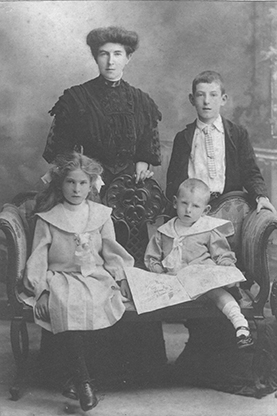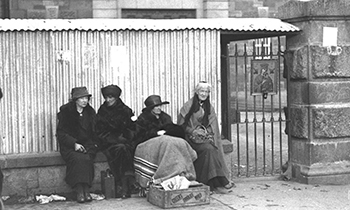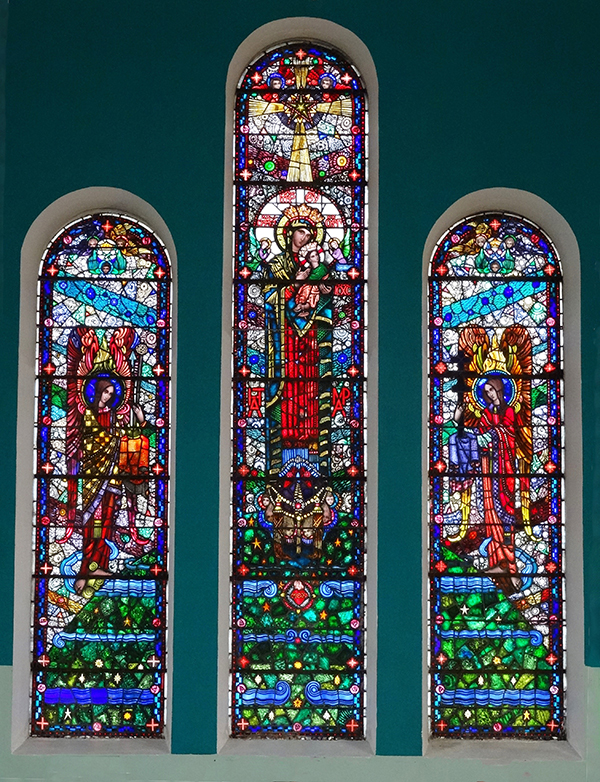SECOND GLANCE: Nell Humphreys and the Mother of Perpetual Succour
Published in Features, Issue 1 (January/February 2021), Volume 29A window dedicated to the women of Cumann na mBan.
By Margaret Ryan

Above: Nell Humphreys c. 1900s with her three children, Dick, Sighle and Emmet. (Kilmainham Collection)
In Mountjoy Prison, hidden from the view of the general public, is a stained-glass three-light window, designed by Richard King, manager of the Harry Clarke studios, depicting the icon of the Mother of Perpetual Succour, donated by a former prisoner and member of Cumann na mBan, Ellen (‘Nell’) Humphreys (née O’Rahilly).
Nell’s daughter, Sighle, in an RTÉ radio interview in 1980, said that her mother in 1918 was only interested in rearing her three children, tending to her garden and saying her prayers. A wealthy widow, 40 years old and a cultural nationalist, Nell Humphreys was the head of an Irish-speaking household. She was arrested shortly after Easter Week when the family home at 54 Northumberland Road was pointed out to British soldiers as a house of rebel sympathisers. She was held for two days in a horsebox in the RDS, Ballsbridge. On 9 May 1916 Nell found herself in the former female prison, Mountjoy, as prisoner 1015, along with eleven other women. Their offence, as listed in the record, was ‘rebellion’. A thirteenth woman was already in the jail—Constance Markievicz.
During Easter Week, Nell’s brother, The O’Rahilly, and her eldest son Dick (then aged twenty) had gone to the GPO to take part in the Rising. On Monday 24 April Nell walked from her house to the GPO to see whether she could persuade Dick to come home with her, but to no avail. She was not deterred; on the next morning she set out again, stopping on her way to visit the Poor Clare Colletine convent on the Simmonscourt Road, where she obtained medals and prayer leaflets encouraging devotion to the Blessed Virgin under her title of Mother of Perpetual Succour. On this occasion, when she arrived at the GPO, Pearse managed to persuade Dick to go home with his mother. Nell then handed over her supply of medals and leaflets to Pearse to distribute to his men, to protect them. Years later, members of the O’Rahilly/Humphreys family met 1916 veterans who said that they still had the medal given to them by Pearse in the GPO.
Her brother, The O’Rahilly, in the morgue
Following the death in the Rising of her brother, The O’Rahilly, Nell recounted her experiences in a letter to her sister-in-law Nora, a nun in Australia.
‘Well I cycled into town with my cousin, the Carmelite Rector in Clarendon Street, and after passing numerous sentries and riding over heaps of broken glass we got to the Morgue. There was Michael [her brother] stretched out on a stand. He was even honoured there, all the others were lying on the ground and he did look fine, Nora. His head thrown back, he had a very high forehead and he looked as brave and peaceful as ever a warrior sculpted in marble on a tomb. Nobody but myself saw him, and ’tis a pity. If Nannie could only have had that impression for her life, it would have made up for much.’
Nannie (Nancy), The O’Rahilly’s widow, was then six months pregnant at the time with their son, Rory.
As a result of the events of that Easter Week Nell Humphreys’s life was transformed and, like many others, she became active in the struggle for Irish independence, joining Sinn Féin and Cumann na mBan. Throughout the subsequent War of Independence she maintained her devotion to the Mother of Perpetual Succour. Ernie O’Malley tells us in a letter that
‘One night in 1917 … our Captain stopped the drill and said “There is a lady, a sister of The O’Rahilly, about to inspect the parade and if I see a smile on any of your faces, God help you when she leaves” … Mrs Nell Humphreys came into the room and gave each of us a medal of Our Lady of Perpetual Succour … It was hard to keep from laughing as our Company was a “tough” one.’
Nell was chosen as a Poor Law delegate by the Sinn Féin Ard Comhairle. She became involved in Cumann na dTeachtaire, a group that stemmed from Cumann na mBan, which sought to obtain equal rights for women as set out in the Proclamation of the Irish Republic—‘Irishmen and Irishwomen’ … ‘equal rights and equal opportunities’. When the First Dáil convened on 21 January 1919, however, only two female Sinn Féin candidates had been elected, one of whom, Constance Markievicz, became minister for labour. She was elected while serving a prison sentence and was released on 10 March 1919 from Holloway Prison in England. Nell and Nannie O’Rahilly met her at the boat in Holyhead, paid for the ticket for her journey and accompanied her across the Irish Sea. Some days later Nell threw a party for the countess to celebrate her return to Ireland.
New house on Ailesbury Road
During the War of Independence, with the help of Sinn Féin activist and developer Batt O’Connor, Nell Humphreys built a new family home at 36 Ailesbury Road. In 1920–1 the house was frequently used as a meeting place for the Dáil Éireann cabinet, IRA headquarters staff and republican courts. Among those who attended these meetings were President de Valera, Cathal Brugha, Michael Collins, Richard Mulcahy, Arthur Griffith and Harry Boland. Incorporated in the house was a secret room on the first floor to hide those on the run from the British authorities, and several underfloor secret drawers to hide documents important to the revolutionary movement.
When the Civil War broke out, Nell’s family took the anti-Treaty side. In early November 1922 her house was raided by the Free State army. Ernie O’Malley, who had been hiding in the secret room there, was captured in the raid. Nell Humphreys found herself back in Mountjoy on 11 November 1922, as did other members of her family, interned under the Coercion Act. Early in her imprisonment she wrote a letter to her aunt:
‘Don’t imagine that I am to be pitied in here. I have been here before [censored words]—I would be almost enjoying myself, everything is so much easier than at home. I can get up any hour I like in the morning, our breakfast is quite good … but all the same for the sake of the past go to our L.P.S.—[censored words] She can make anything right.’
The female republican prisoners organised themselves in Mountjoy. The majority were members of Cumann na mBan. Older women like Nell Humphreys were given command roles. On the top landing of B wing she had an altar erected, with a picture of the Mother of Perpetual Succour. She would daily call her fellow inmates to pray at this altar by banging an enamel plate with a spoon, and she rostered groups of women for all-night prayer vigils. Many of the younger women did not like the praying so much and nicknamed her ‘Officer Commanding God ‘and ‘Officer Commanding Prayers’.
‘May Langan’s wake’
The good conditions described in Nell’s letter did not continue, however. At various times the prison became overcrowded and the prison authorities would place extra beds in the cells. The women would take these beds and put them out on the landings in protest. One night a prisoner, May Langan, was admitted to the jail at midnight. She was the landlady of a Dublin boarding-house and had been arrested because a family of anti-Treaty republicans, the Gallaghers, were boarding in her house. As it was late and in order not to disturb other prisoners, she was told to sleep for the night in a bed on the landing that happened to be under the altar. Early next morning the women quietly assembled around the bed and the altar for morning prayer. Then May Langan woke up and got the fright of her life. She thought that she had died in the night and that the women were gathered to pray for her soul. That incident became known as ‘May Langan’s wake’.
The women in Mountjoy agitated for better conditions and for political status, as was afforded to male political prisoners. An anonymous poem included in captured papers expresses the sentiments of a woman internee about her time in Mountjoy:
‘Would you like to go back to Kilmainham Jail
Where you don’t have to sweep the floors,
Stroll around the old compound
And take hinges off the doors.
Where you get clean sheets every second week
And letters each day without fail.
When the tears come, I know,
The heart aches to go
Back to Kilmainham Jail.’
Hunger strikes

Above: Annie McSwiney (under blankets)—with Charlotte Despard to her left and Maud Gonne McBride to her right—on hunger strike outside Mountjoy Prison in November 1922. A picture of the Mother of Perpetual Succour hangs beside them on the gate. (NLI)
In November 1922 Mary McSwiney’s was the first of the hunger strikes to begin in the female prison. At the same time, her sister Annie embarked on a hunger strike outside the gates of Mountjoy, supported by members of the Women Prisoners’ Defence League (WPDL). A picture of the Mother of Perpetual Succour hung beside them on the gates of Mountjoy. The Daily Mirror reported that it was placed there by Annie McSwiney before she undertook her hunger strike. During the War of Independence, the Catholic Bulletin of June 1920 had also reported that an image of the Mother of Perpetual Succour had been erected at the gates by the mother of a Mountjoy hunger striker. According to her daughter Sighle, that mother was Nell:
‘Mama then got a banner with Our Lady of Perpetual Succour emblazoned on it. She wanted the IRA to march behind it to the prison gates but they would not do that. Very chivalrously Seán McBride offered to carry it. It was pinned to the gate of the jail and remained there for weeks.’
To frustrate the WPDL and their supporters, Free State soldiers at times hosed them and fired shots over their heads. This only gained their cause much publicity. On the other hand, the wits of Dublin nicknamed the founders of the WPDL ‘Maud Gonne Mad and Charlotte Desperate’.
The female prisoners in Mountjoy were regularly subjected to random searches and had rounds of live ammunition fired over their heads by the soldiers who guarded them. During one such episode the windows of the chapel were badly damaged. Despite the tough conditions and violence, many Catholic women in prison at this time have said that what hurt them most was their treatment by their church. In October 1922 the Catholic hierarchy in a pastoral letter stated that those involved on the anti-Treaty side of the Civil War were guilty of the ‘gravest sins and may not be absolved in Confession, nor admitted to Holy Communion’. In Mountjoy women political prisoners were refused Communion. On 12 January 1923, led by Nell Humphreys, 36 female prisoners attempted to go to the prison chapel for Confession. They were refused.
Nell Humphries was moved to Kilmainham Gaol in February 1923. Here she had Grace Gifford, artist and widow of the executed 1916 leader Joseph Mary Plunkett, decorate an altar in honour of the Mother of Perpetual Succour. Once again Nell set about calling the women prisoners to prayer. On the anniversary of the Easter Rising, Sunday 24 April 1923, a group of 270 female inmates gathered in the yard of Kilmainham Gaol. Grace Gifford Plunkett laid a wreath where her husband had been executed and Nell led the assembly in the Rosary, recited in Irish.
Having also been interned in the North Dublin Union around the end of April before being returned to Kilmainham, Nell was finally released on 17 July 1923. She had been incarcerated for 249 days.
In 1923 Nell Humphreys was elected as a Sinn Féin representative to Pembroke Urban Council. The following year she resigned her membership of the O’Rahilly Sinn Féin Club in Donnybrook. She continued in public service as an independent councillor, being very committed to helping the poor in the Pembroke area.
The window
On 27 March 1939 Nell went to the Harry Clarke Studios, North Frederick Street, Dublin. She placed an order for a stained-glass three-light window to contain the image of the Mother of Perpetual Succour. This window was to replace the original in the chapel of the former female prison in Mountjoy that had been damaged by gunfire during the Civil War. Correspondence between Nell and the designer shows that she wanted the window to reflect, as closely as possible, the features of the original icon. It cost £460.

Above: Nell Humphreys’s three-light stained-glass window depicting the Mother of Perpetual Succour in the chapel of the former female prison in Mountjoy. Sadly, she didn’t live to see it installed in October 1939.
The window was installed at 4pm on 15 October 1939 in a ceremony performed by Revd Canon McMahon, PP Clontarf, former chaplain to the prison during the Civil War. Nell’s daughter, Sighle, unveiled a plaque that dedicated the window to the women of Cumann na mBan. Members of Nell’s family were there on that day but Nell herself was not present. She had died on the morning of Thursday 8 June 1939 at her home. Nell Humphreys never saw her beautiful window.
Margaret Ryan is a retired educator with the City of Dublin Education and Training Board service to prisons.
FURTHER READING
S. McCoole, No ordinary women: Irish female activists in the revolutionary years 1900–1923 (Dublin, 2015).
U. McEoin, Survivors (Dublin, 1980).
L. Naughton (ed.), Markievicz: prison letters and rebel writings (Dublin, 2018).
R. Sheehy, The life and work of Richard King: religion, nationalism and modernism (Witney, 2019).
















